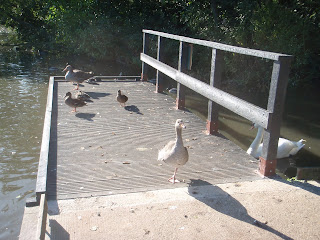
Summer is upon us and Elvetham Heath Local Nature Reserve is buzzing with life. It is a great time to see DRAGONFLIES and DAMSELFLIES. These brightly coloured insects are powerful predators and can be seen on warm days darting about and making low flights across the undergrowth as they hunt for other insects. When at rest dragonflies wings are held outwards and those of damselflies are held against their bodies, damselflies are typically more slender and delicate in appearance than most dragonflies. The dragonfly pictured is a SOUTHERN HAWKER (courtesy of Tony Mundell); this species will be seen on the wing from mid July. Sixteen species of dragonfly and damselfly have been recorded within the reserve. Although there have been unconfirmed reports of a further two species, as soon as I here anything I will update the blog.
Species recorded this year include:
Common Blue Damselfly – this could be considered to be the most typical British damselfly. It is a very common species found in a range of habitats.
Azure Damselfly – a very common species and distinguished from the Common Blue by a characteristic flat-bottomed "U" shaped mark on the second abdominal segment (in the male).
Blue-tailed Damselfly – a very common species and found in a very wide range of lowland habitats including brackish or polluted water where it may be the only species present. The males have a blue spot on the tail (segment 8).
Small Red Damselfly – the male has an all red abdomen. The female exists in several colour forms from red and black on the abdomen to nearly all black. Both sexes have a bronze-black thorax and red legs. This species is nationally scarce and is restricted to shallow heathland pools.
Large Red Damselfly – a very common species found throughout the UK. It is a large, active, deep red damselfly with black legs and a bronze-black top to the thorax which has broad red or yellow stripes. The female exists in several colour forms varying in the amount of red and black on the abdomen. This is one of the earliest species to appear each spring.
Beautiful Demoiselle – in this species the wings of the mature male are very dark blue-black and those of the female are iridescent brown-green. The body colour is metallic blue-green in the male and green with a bronze tip in the female. The flight is fluttering, butterfly-like. They typically breed in shallow flowing water with sandy or gravel bottoms.
Emperor Dragonfly – Britain's bulkiest Dragonfly. Its bright colours and active habit make it very obvious when hunting over medium to large water bodies. It rarely settles, even eating its prey in flight. Both sexes have a bright, apple-green thorax and green or blue eyes. The male has a sky blue abdomen with a central dark line.
The female has a green abdomen, similarly marked, which may become blue in warm weather.
Golden-ringed Dragonfly – a stunning black insect with yellow rings along the length of the abdomen. The female is the UKs longest dragonfly because of her long ovipositor (apparatus for laying eggs). This species breeds in streams and typically hunts on heathland.
Four-spotted Chaser – the sexes are alike with a brown abdomen becoming darker towards the rear, a brown thorax and brown eyes. The most noticeable feature is the colouring of the wings. Each of the four wings contains a very dark spot, which gives the insect its name.
Broad-bodied Chaser – a very common species which typically colonises new ponds. The very broad, flattened abdomen is characteristic making the insect appears "fat". The males quickly develop a blue abdomen with yellow spots along the segment sides. Females are a golden brown on the abdomen, again with yellow spots at the margins.
Keeled Skimmer – This species processes a slender abdomen with a pronounced keel on the upper side. The males develop a blue abdomen. Females have a pale, yellowish-brown abdomen with a medial black line. It is typically found around pools and streams on heathland.
Black-tailed Skimmer – a fairly common species, females and immature specimens are pale, yellowish brown with two bold lines running along the length of the abdomen. The males develop a blue abdomen darkening to the rear with segment 8-10 becoming black. Its eyes are very dark green. They fly swift and low, skimming the water surface.
Common Darter – A common summer and autumn species, this dragonfly can be found well into November and may be one of the last on the wing in the UK. The thorax in both sexes is brown above with stripes and yellow panels on the sides. The eyes are brown above and yellow below. The males become a bright orange-red with maturity. Females have a pale, yellowish-brown abdomen.
Other species regularly recorded:
Emerald Damselfly – This species is locally common and can be found in pond side rushes and reeds. Both sexes are metallic green. The Emerald Damselfly rests with its wings spread at about 45° to the body.
Red-eyed Damselfly – a robust looking damselfly with a dark greyish abdomen and a blue "tail" in the male. The eyes of the male are deep red and the thorax in both sexes is bronze black on top. Found on large ponds, lakes and canals, the male typically sites on a water-lily and defends it against newcomers.
Southern Hawker – a large, inquisitive dragonfly usually seen individually. The spots on segments section 8-10 are joined, unlike other Hawkers. The male is brightly marked on a dark background, usually apple green except for segments 8-10, which are pale blue. Occasionally, all pale blue marked individuals are seen. The female is brown with bright green markings. This species is fairly common and can be found some distance from water.




















